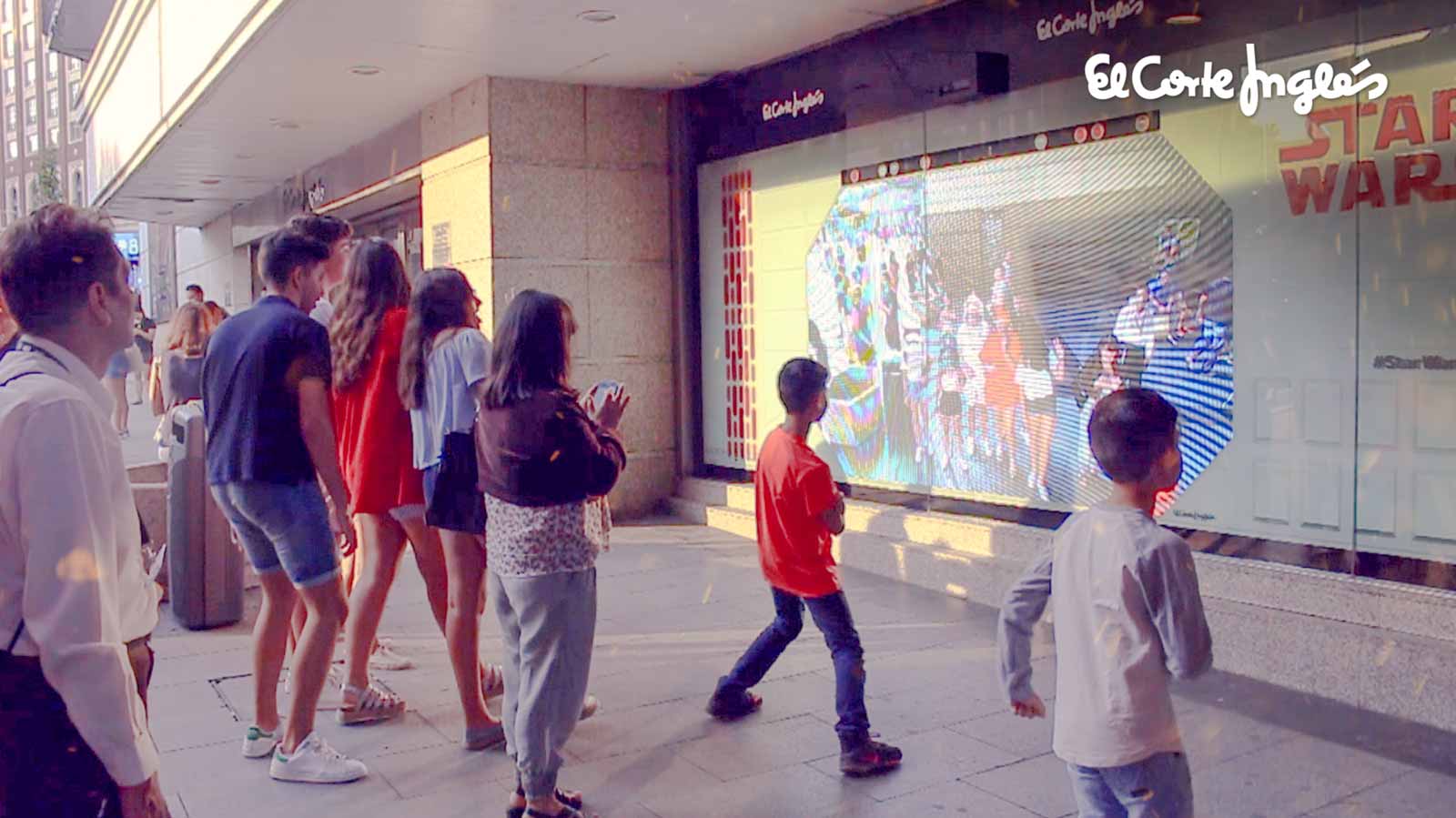Virtual fitting rooms as a trend in the retail sector
If there is a sector that is in constant evolution, it is the retail sector. We are living in the golden age of online commerce, we are witnessing the emergence of new sales channels and physical stores are revolutionizing the concept of customer experience with new phygital propositions.
Undoubtedly, this is a technological and digital transformation that is born with the objective of: differentiating itself from the competition, connecting emotionally with users, and attract and surprise with unique proposals.
In this article we will focus on one of the most versatile technological solutions for the retail sector, the virtual testers.
Surprising experiences that can be developed for both e-commerce and physical stores, with technologies ranging from Augmented Reality through mobile devices to 3D simulators in Virtual Reality. And even, phygital facilities such as showcases and virtualized physical testers. Different solutions that allow users to try and see products first hand. From clothing and accessories, to decoration, automobiles and even tourist services.
What are virtual testers?
Before knowing how to implement this technological trend in a store or e-commerce, it is important to know what are virtual testers.
Virtual testers are technological solutions that allow users to visualize/use a product or service without having to physically test it. Mainly to through Augmented Reality technology.which allows to superimpose digital elements over the reality itself, enriching and "augmenting" it.
Augmented Reality applied to the retail sector, and specifically to virtual fitting rooms, allows for superimpose on the user's own all kinds of clothes, accessories, hairstyles, dyes and makeup, which allows the user to see how they would look in a personalized way; and also on the real space, ideal for testing how a certain piece of furniture would look in a room or the real-size machinery in the industrial factory.

Virtual testers: how do they work?
The virtual testers are from the more versatile technological experiencesThey adapt to all types of devices, allowing both online and purely physical stores to incorporate them into their proposals to attract customers and innovatively showcase their products.
At the mobile level, virtual fitting rooms in AR allow the user to see through their own device the product in real size, adapting to both the space and the body, allowing the user to see how it would look prior to purchase, as if they were in a normal physical fitting room.
At the physical store level, on screens or interactive totems, virtual fitting rooms allow not only to test products (such as garments, accessories and cosmetics), but also to incorporate these products into the store. experiences as outdoor advertising/showcasesThe aim was to attract passers-by to the stores. An example of this can be found in the marketing action carried out by the El Corte Ingles together with Disney in Madrid's iconic Plaza de Callao for the promotion of one of the latest Star Wars movies..
4 benefits of virtual fitting rooms in the retail sector
The intelligent virtual fitting room in the retail sector allows the user to see himself reflected, but instead of doing as he would in a mirror, his reflection shows him different garments, complements and interfaces that allow him to wear the next level shopping experience.
The following are the 4 main benefits of virtual testers in the retail sector.
Differentiating element
Having virtual testers in your shop/e-commerce is a surprising and fun elementwhere word of mouth is enhanced thanks to its great capacity for dissemination and viralization in Social Networks.
In addition, they are a unique way to differentiation from the competition, where the most emblematic streets have dozens of retail businesses. A virtual fitting room or even an interactive virtual showcase is a differentiating element that attracts attention and attracts users.
Boosting personalized recommendations
A virtual tester allows connect in a more personalized way with customers. Where they can not only see how the garment would look on them, but also receive advice and recommendations of combinations, see the availability of colors and sizes and even pay for the garment from the fitting room itself.
If the Artificial Intelligence and the avatars more humanized, the user can explain his needs and the intelligent virtual tester can offer him the item that best suits him, thanks to its personalized training in product information.
You may be interested in→ Generative Avatars with Artificial Intelligence
Dashboards and analytics
In addition to revolutionizing the shopping experience for customers, virtual fitting rooms and other phygital experiences applied to the retail sector offer brands the ability to analysis and measurement capabilities as if they were digital marketing strategies.
They can obtain data as relevant as the time spentthe most selected productsthe no. of consultations The number of visitors' contact emails and the number of impacts per hour and per day. Revolutionizing both the brand image and user acquisition, as well as the dashboards and analytics of D.O.O.H (digital out of home) actions.
Gamifying the experience: online & phygital
Virtual fitting rooms, interactive shop windows and Augmented Reality in the retail sector have a positive impact on the public in a positive way. effective, original and unobtrusive.
Using these technological solutions in both its online and offline proposal, the user's shopping experience is gamified. Making the experience go beyond just looking at the catalog or walking through the physical space. As far as physical stores are concerned, the gamification these places to become a place where the meeting points where you can have fun and be surprised.
A unique proposal that motivates the effect called by involving users in the promotional action, encouraging brand recall, the recommendation of new products and also sales. A way to digitize and liven up the shopping experience that has already been implemented in the mall. La Torre Outlet.
Trends in the retail sector
The incorporation of virtual fitting rooms is one of the main technological trends in the retail sector, but it is not the only one. If there is a sector where the innovationthe creativity and the fun are key factors to connect with the audience, is the retail sector.
Among the major technologies that are applied in this industry are solutions focused on the Metaversein the Artificial Intelligencein the Virtual Reality and in the new digital economy, led by the NFTsthe cryptocurrencies and the blockchain. Here are some examples:
Showrooms in the Metaverse
A virtual showroom is an exclusive and groundbreaking digital environment that revolutionizes the shopping experience as well as the presentation of products in the virtual world. Turning this new online storefront space into a a place for meeting, visibility and proximity where the brand exhibits its new products and shares with its public and customers its essence, its brand philosophy and its future projections, going beyond the physical stores and the usual online stores.
These spaces allow building the brand's digital world from scratchchanging the shopping experience from a simple online store to a personalized, unique and innovative virtual space.
Among the proposals that have already seen the light of day, we find the interactive house of Lèkuè. An own virtual space where you can see in action and know in first person all their kitchen products.
3D Simulations
If the advent of websites revolutionized the retail sector with the advent of e-commerce, the next big technological leap virtual experiences are the main protagonists.
Thanks to advances in Virtual Reality, the shopping experience is transformed with the new more intuitive and immersive virtual stores, where a whole series of actions can be performed as if it were a physical store, but from the comfort of the home.
Virtual Reality also makes it possible to recreate showrooms and even workshops, where users can immerse themselves in the process and manufacture their customized products themselves as if they were in a video game.
In addition, these technologies not only make it possible to view the products, but also to test them in gamified experiences. With 3D simulations where customers drive the latest car model or discover the latest news of the ski season together with Ibercaja Xplora in the Frozen Emotion project, a virtual simulation of the great winter sport of the Aragonese Pyrenees.
Artificial Intelligence Avatars
The arrival of the Generative Artificial Intelligence has revolutionized all sectors, including the retail sector. Now, recommendations and customer service in physical stores and e-commerces goes one step further, with the incorporation of Artificial Intelligence avatars trained with all the information about the products, brands and commercial protocols of the company itself, becoming real virtual salespeople.
They can hold conversations with customers, answer their questions and offer recommendations based on their needs. Being true brand ambassadors. An example of this can be found in V-E-G-AThe company's AI avatar provides all the information about the company's applications, products and projects.
Phygital experience
A Kimchi! or Interactive Showcase is a phygital experience that utilizes the Augmented Reality for bring the virtual universe into the physical world. Through animations, special effects, gamified challenges, games and photocalls, users are immersed in a completely new virtual world created around them. All this to revolutionize the physical presence and promotional actions of brands, attracting all eyes.
You may be interested in→ Our Kimchi project! Star wars
These large-scale Augmented Reality experiences are one of the most innovative trends of the DOOH marketing (digital out of home) where the presence, immediacy and proximity of face-to-face actions is combined with the latest advances in the digital world in terms of personalization, interaction and dashboards. All this so that the essence of the brand reaches users in a totally innovative, entertaining and fun way.
NFTs and Blockchain
A NFT is a non-fungible token, i.e. a digital asset whose value resides in its exclusivity and in the security offered by its blockchain technology for certify its authenticityThe retail sector, in particular the fashion sector, is a key sector for the fashion industry.
We are currently seeing the development of phygital capsule collectionswhere the customer's purchase of the NFT gives them access to a physical garment and a loyalty club. This creates a feeling of exclusivity y belonging to the brand.
The brand, on the other hand, guarantees authenticity and traceability of each garment, increasing the value of the shopping experience and solving two of the main problems in fashion and retail: overproduction and counterfeiting.
Thanks to the incorporation of this technology, it is possible to make to order by selling NFTs, avoiding excess inventory, reducing the environmental impact and generating, at the same time, great expectation among customers. Making shopping an experience that goes beyond the purchase of the product.
Virtual fitting rooms: the future of retail
At Imascono we know that the future of the retail sector The integration of new innovative experiences, such as virtual workers, the Artificial Intelligence and the Metaverse.
For this reason, we have a team of 30 engineers and developers specializing in Extended Reality that can help you making the leap into digital metamorphosis of your business with the incorporation of these technological breakthroughs.
Do you need a virtual fitting room or innovative retail experience? ¡Contact us at!



